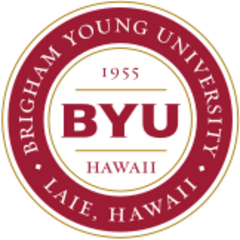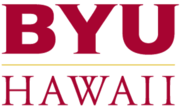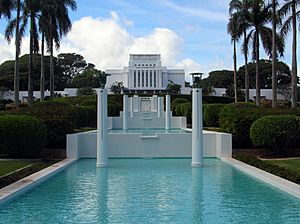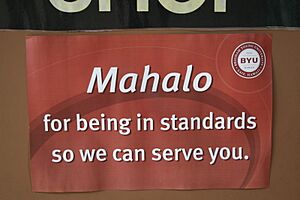Brigham Young University–Hawaii facts for kids
 |
|
|
Former names
|
Church College of Hawaii (1955–1974) |
|---|---|
| Motto | Enter to learn, go forth to serve |
| Type | Private college |
| Established | September 26, 1955 |
|
Parent institution
|
Church Educational System |
| Accreditation | WSCUC |
|
Religious affiliation
|
The Church of Jesus Christ of Latter-day Saints |
| President | John S. K. Kauwe III |
|
Academic staff
|
127 faculty, 105 adjunct faculty (Fall 2023) |
| Students | 2,836 (Fall 2023) |
| Location |
,
Hawaii
,
United States
21°38′29″N 157°55′31″W / 21.64139°N 157.92528°W |
| Campus | Rural, 100 acres (40 ha) |
| Newspaper | Ke Alaka'i |
| Colors | Crimson, Gold |
| Mascot | Seasiders |
 |
|
Brigham Young University–Hawaii (BYU–Hawaii) is a private college located in the town of Laie on the island of Oahu. It is owned and run by The Church of Jesus Christ of Latter-day Saints (LDS Church). The school focuses on teaching undergraduate students, which are students working toward their first four-year degree.
BYU–Hawaii first opened in 1955. It is part of the Church Educational System (CES), which also includes sister schools like Brigham Young University in Utah and BYU-Idaho. About 97 percent of the college's 2,800 students are members of the LDS Church. All students at BYU–Hawaii agree to follow an Honor Code, which is a set of rules based on the teachings of the LDS Church.
Contents
History of the University

The LDS Church has been in Hawaii since 1850. By 1919, the church built a temple in Laie. A church leader named David O. McKay visited two years later and said that one day, a school would be built there too. In 1951, McKay, who was then the president of the church, started making plans for the school.
The Early Years
The school officially opened in September 1955. It was first called the Church College of Hawaii. The first class had 153 students and 20 teachers. They held classes in old buildings from World War II. The first new buildings for the college were finished in 1958.
At first, it was a two-year college. But in 1959, it changed to a four-year college. This allowed students to earn a full bachelor's degree.
Growth and Changes
In 1963, the Polynesian Cultural Center was opened next to the college. It was created to share and preserve the cultures of the Pacific Islands. The center also provided jobs for many students at the college, helping them pay for their education.
In 1974, the school's name was changed to Brigham Young University–Hawaii. It became a branch campus of the main Brigham Young University in Utah. However, in 2004, it became its own separate university, reporting directly to the head of the Church Educational System.
Over the years, the university has had several presidents. On July 1, 2020, John S. K. Kauwe III became the current president of BYU–Hawaii.
Campus and Student Life
BYU–Hawaii is on the north shore of Oahu, about 35 miles from Honolulu. The campus is 100 acres (40 ha) and sits between beautiful mountains and the Pacific Ocean.
Student dormitories, called "Hales," can house over 1,200 students. There are also apartments for married students right next to the Laie Hawaii Temple. The campus library is the two-story Joseph F. Smith Library.
Who Can Attend?
Students who are members of the LDS Church pay a lower tuition fee. The school also considers if an applicant has served an LDS mission. However, you do not have to be a member of the church to attend.
To get in, students usually need good grades from high school (at least a B average). They also need good scores on college entrance exams like the ACT or SAT.
The Honor Code
All students and teachers at BYU–Hawaii promise to follow an honor code. This code includes rules about being honest in schoolwork, dressing modestly, and living a healthy lifestyle. For example, students agree to avoid alcohol and smoking.
The Honor Code is an important part of the university's goal to create a positive and safe learning environment for everyone.
What Can You Study?
BYU–Hawaii offers 37 different bachelor's degree programs. The university has a 16-to-1 student-to-teacher ratio, which means classes are often small. In 2018, the school organized its programs into seven main groups called "faculty units":
- Arts & Letters: Includes subjects like communication, English, and art.
- Business & Government: For students interested in accounting, business, and political science.
- Culture, Language & Performing Arts: Offers programs in history, music, and Pacific Island studies.
- Education & Social Work: Prepares students to become teachers or social workers.
- Math & Computing: Includes computer science, information technology, and math.
- Religious Education: All students take religion classes as part of their education.
- Sciences: For subjects like biology, chemistry, and psychology.
University Athletics
BYU–Hawaii used to have a successful sports program. The teams were called the "Seasiders" and they competed in the NCAA Division II. The university had teams for basketball, soccer, tennis, volleyball, and more.
Over the years, the Seasiders won many championships, especially in women's volleyball and tennis.
In 2014, the university announced it would end its sports programs. The last teams competed in 2017. The school decided to use the money from athletics to give scholarships to 500 more students, helping more people get an education.
Famous Alumni
Some well-known people who graduated from BYU–Hawaii include:
- Eni Faleomavaega, who served as a delegate to the U.S. Congress for American Samoa.
- Mike Wilton, a famous college volleyball coach.


